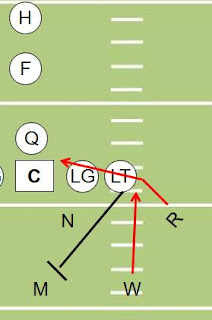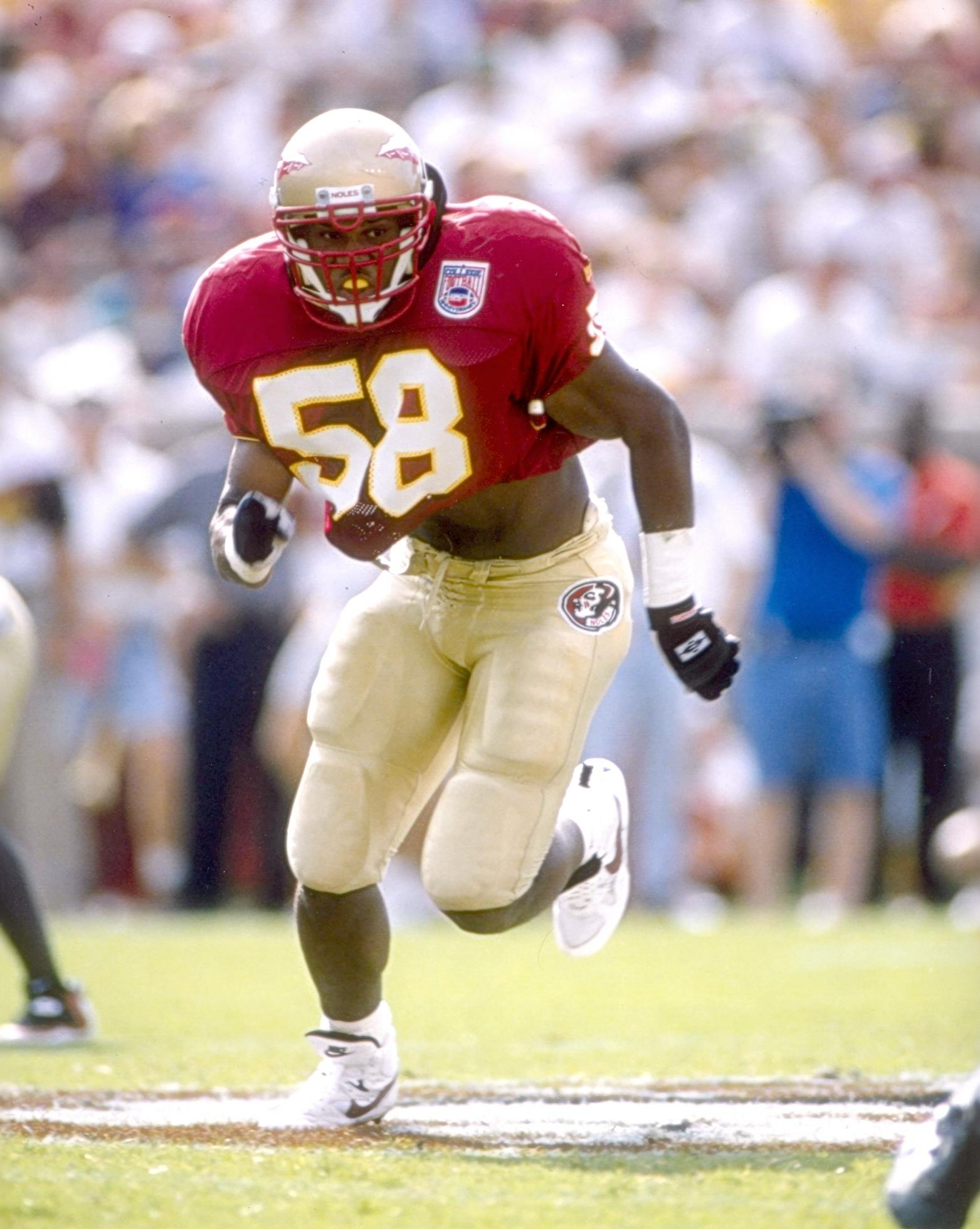I have had the privilege these past two seasons to coach using this technique and I thought I would share some of the pros and con's of it with my readers. First off, the technique is nothing miraculous, and many have seen it for years. I actually have coached with some coaches that have based their entire scheme off of this technique with quite some success. Some readers on here will recognize the technique being very similar to that of a defense I had researched in the past called the 4-3 Scream and Splatter defense.
Background
One of the first times I saw this technique was in November of 1996 when FSU beat Florida in Tallahassee, on what would lead to the best revenge game I've ever seen in the national championship game that year. Florida lost that regular season contest 24-21 and Florida quarterback Danny Weurffel took the worst beating I've ever seen a quarterback take in that game. Weurffel was sacked 6 times and hurried numerous other times that game by the likes of Peter Bouleware, Reinard Wilson, Andre Wadsworth and countless other Seminole defenders. I never gave it another thought until in 2005, the team I was coaching was facing an opponent that had it's defensive ends in an odd look. They were tilted, looking almost in, down the offensive line at a severe angle. I remember back in the day, the Jimmy Johnson 4-3 guys called this "Smoke", but I'd never seen such a radical tilt by a defensive end. The other thing I noticed, when watching our opponent on film, was the absolute reckless abandonment the ends had. They flew in like mad hornets, struck whatever was in their path, ran down plays from behind, and in general, made life miserable for opponents. The defensive coordinator (DC) I was working for at the time, when asked about this, called it the "jet technique". He had heard the opposing head coach speak at a clinic a few years earlier on the technique and how it worked. The more and more I watched it, the more I was absolutely mesmerized by it. Now, don't get me wrong, our opponent had some cats, they could flat get with it, and their entire defense played with this reckless abandonment. Anyhow, in the span of 10 seasons, I faced this team at least once every year, only beating them one time. In seven out of 10 seasons, they utilized the jet technique with great success. Having had the chance to work with several members of that staff here in the recently, I'm going to elaborate more on how it is taught, it's similarities to regular, block down, step down (BDSD), how not to play the technique and the pros and con's of the technique. I will also add in how this technique ties into the linebacker play behind it. A lot of this will not be new, but what will be new is the manner in which the scheme is delivered, by turning loose some of your most aggressive players on some of the offense's weakest players.
The technique
The technique is no different than that of a standard BDSD defensive end. I had to learn this pretty quickly, as on film, it does not look quite the same. The reads are basically the same versus the four standard blocks a defensive end will see.
- Base block- the DE will attack the near hip and press the blocker back down inside to constrict the running lane and play the spill by the outside linebacker (OLB).
- Reach block- the DE will attack the near hip of the blocker and work vertical, to set the edge and force the ball carrier to either cut back, or to "bubble" into the backfield.
- Down block- the DE will come flat down the line attacking the first threat to him as he reads down the line to up the field. This threat could be a pulling guard, kicking out lead blocker, a dive back, or the ball being run away from the DE. In the case of the ball being run away, the DE is to chase, chase, chase with reckless abandonment in an attempt to get to the football.
- Pass block- the DE will attack the near hip, and work vertical to contain the quarterback in the pocket.
 |
| Jet vs. base block |
 |
| Jet vs. reach block |
 |
| Jet vs. down block |
The key component, as with any technique, of jetting, is the footwork of the DE. The DE must not step up field. I cannot stress this enough, as if the DE is up the field, he has made the offense's job that much easier blocking him. The DE must step AT his target. Even though hand placement, as with standard BDSD, is not critical, the steps, still are. The DE must step at his target, THEN make his read and adjust his path to the attack point accordingly. A key item in teaching the DE's feet, is the placement of the down hand when in his stance. If at all possible, get your DE's to play with their inside hand down. This will almost naturally force the DE to step into his target. As with anything that involves technique, the footwork is ever-so critical when teaching jetting.
As you can see, this is all pretty standard stuff. No real shockers in technique here. What is the shocker, is what a simple change in alignment, stance and mentality can allow for when it comes to the selection of personnel.
Alignment, Stance and Purpose
The DE assumes a sprinters stance, looking down the line of scrimmage (LOS). In some cases, the DE is actually parallel with the LOS. The DE will align one yard outside the EMOL and take this tilted stance. What this alignment and stance do, is allow the DE to come off like a rocket (we often used to call them "wick lighters" or "bottle rockets"), attacking the blocker at a very high rate of speed. This makes the defender very difficult to block due to the high rate of speed they can attain. The more athletic the DE, the wider he can align, thereby making it more difficult for him to be blocked. The width of alignment also gives the DE the element of time to diagnose the read he is getting. It also clarifies this read, because of the width of the DE, the blocker has to make a tremendous effort to get to him on the base and reach blocks.
The purpose behind all this, is to allow the DE's to play fast and be reckless. Many coaches having called jet DE's "wrecking balls" or "crash test dummies". The other purpose behind the technique is that it allows a smaller, quicker athlete to play the defensive end position. Not everyone is blessed with 6'2" 220 pound DE's in high school. I have seen DE's as small as 160 pounds play this position with great effectiveness. The key element with this technique, is the selection of the player to play this position.
Player Selection
The jet DE needs to be some of the names I've mentioned above, such as "wick lighter", "wrecking ball" or "crash test dummy". They need to be relentless, have zero fear of contact, and understand their role within the defense. They must be a player that knows, they may not get very many tackles, but that they will get to make contact on just about every play in the game. The DE must relish contact. He must not shy away from it, and as many have said, he must be the "bull in the China shop". Our opponent for the past ten years, has utilized extra wide receivers, tight ends, and even running backs that weren't labeled as "offensive players" to fill this role. They all shared the above traits in that there was a universal love of contact. A lesser athlete can pay this technique, but it does need to be modified a bit by tilting the DE more parallel to the LOS and playing him a bit closer to his read, so that he can close the edge a bit better on down block reads.
Pro's and Con's of the Jet Technique
The pro's of the technique are as follows:
- It allows for smaller, quicker players to play defensive end in a four man line. How many times have you heard a coach switch to the 3-3 or the 3-4 because "we just don't have that many defensive linemen (DL). Jetting, allows the smaller quicker player be effective, so long as they like contact and are not selfish.
- The smaller, quicker player, coupled with the wide alignment makes the DE very tough to block. You can almost count on not reach blocking this player with an offensive tackle, and even tight ends (TE's) have trouble with them. Their head of steam coming off the ball, coupled with their quickness usually stones lead blockers coming from depth, even if said lead blocker outweighs the DE. You can try optioning off of them, but the quarterback is usually going to pay because of the ferocity at which these DE's come off the football.
- The reads are very simple, and are a visual key, rather than a feeling key (the way BDSD is). For years, I've had trouble with the DL getting their hands on a blocker to be able to "feel" the blocking scheme. The jet technique plays right into what kids use most, their eyes. The DE doesn't have to feel what the blocker is doing, he gets to see it, then attack it. By playing into what most high school players already utilize the most, their vision, it allows them to play fast and aggressive, as they trust their reads.
- It is easy to teach. You can literally teach the technique and reads in one practice session. The key is continually repping the fits of the various blocks. The other key is breaking any selfishness by a DE wanting to "make a play" and not stay within the scheme.
The con's of the jet technique are:
- It exposes linebackers (LB's) to down blocks. This point is argumentative, but I bring it up, because it is the largest flaw I have with the technique. Since the DE does not get hands on the blocker, the blocker gets a free release to a linebacker. Now, if it's the OLB, this block is very tough, however if it is the middle linebacker (MLB), then this block is executed quite easily. The argument here by the proponents are that because the DE "wrecks" shop in the backfield and spills the ball laterally, it allows time for the MLB to get off this down block and pursue the football. I'm sure this could be debated for hours, but this is my number one gripe with the technique.
- Lesser athletes struggle playing the position. In my opinion, you need some pretty athletic DE's to play this spot. They need to be able to see the read and redirect on the run. Some kids I've coached, quite simply do not have the natural ability to do this. If they do not, you can adjust the stance and the alignment some, but not to the point that it is as effective as if the player was a very good athlete.
- It requires an absolute desire for contact. In this day and age of the "softening football player", it may be hard to institute this technique because the player must be willing to sacrifice statistics for the love of contact. Many players we get, simply don't like this, and are very hard to break of their selfishness. The other thing, is that if they are soft on contact the DE will not be in a great position to constrict running lanes on base blocks, or spill the ball on down blocking gap schemes.
Jet Technique Coupled with Linebacker Reads
Again, none of this should be Earth shattering, but all of it, is very fundamental in teaching the reads and run fits of the four man front when utilizing the jet technique. Looking at the reads, from the four reads given above, the LB would react as follows:
- Base block- the way I have taught the technique, to keep it simple is if the DE is outside with his read, the LB is inside with his. If the DE is inside, the LB is outside. So versus the base block, the DE is attacking the hip and constricting the inside run lane and is outside, so the LB must fit inside this block into the open gap the offense is presenting.
- Reach block- the reach is taught similar to the base, but once the ball has declared itself out of the LB's open gap, he is free to scrape and chase the football outside where the secondary run support should be turning the ball back into both the DE and the OLB.
- Down block- on the down block, the DE is inside, so the LB must gap exchange and now be outside. The LB will scrape and replace the DE, as the DE spills the block, or tackles the dive back. Again, nothing new from BDSD, other than how the DE attacks the blocker.
- Pass block- obviously here, the OLB would read that the OL is pass blocking, and will now get into whatever pass drop the coverage the defense is in would require.
 |
| LB reaction vs. base block on DE |
 |
| LB reaction vs. reach block on the DE |
 |
| LB reaction vs. down block (note how exposed the MLB is on this play) |
Conclusion
In conclusion, I think the technique has merit. However, I think you have to have the right folks to run it. You have to have some absolute wrecking balls at the DE position, that love contact and are not selfish players. As with any technique it must be taught properly as well. Improper technique will lead to the DE being out of position which, in turn, leads to huge holes created in the defense. If properly taught, with the right individuals playing the technique, one can have some very good success using Mickey Andrew's jet technique.
Duece




